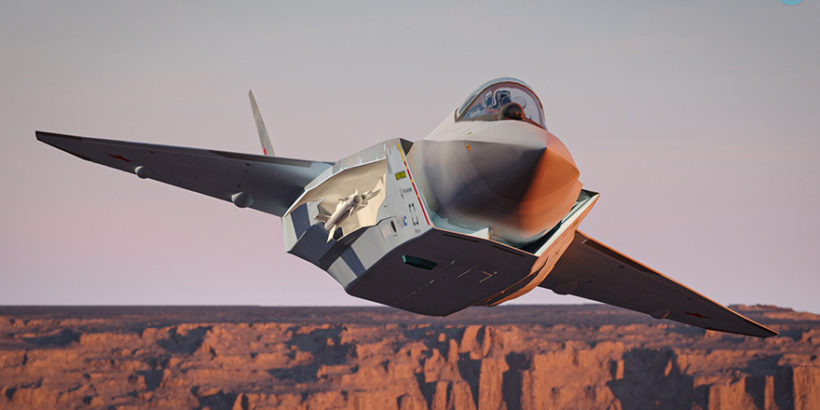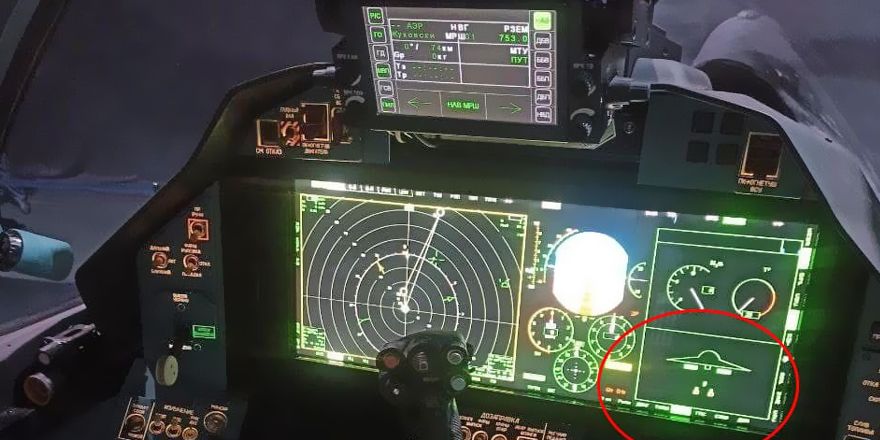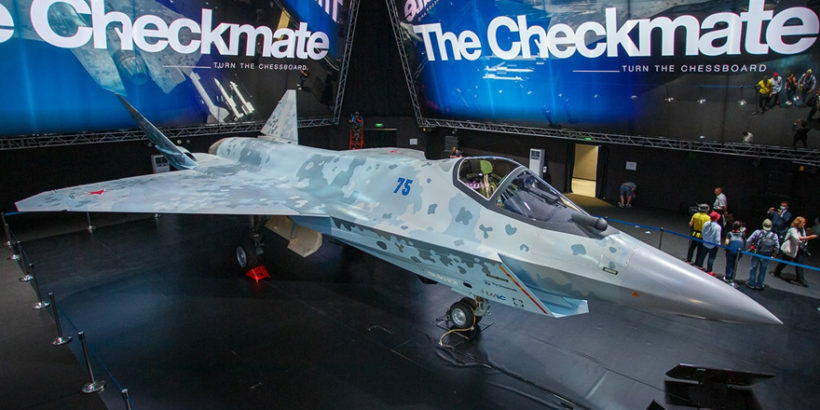There is only one machine today in the fifth-generation single-engine fighter class in the world – the F-35 Lightning II, but this fighter is offered exclusively to a “select few” – members of the North Atlantic Alliance and allies of the United States. At the same time, the aircraft is very expensive and does not always meet the requirements that are put forward by the military in different countries, neither in terms of flight characteristics, nor in terms of armament, nor in terms of reliability.
For example, Switzerland was offered to buy 36 F-35A fighters for $5.4 billion, i.e., $150 million for one machine. According to the U.S. Department of Defense, the cost of the F-35A for the U.S. Air Force in 2021 will be $79.17 million and $77.9 million in 2022.
The Checkmate light tactical fighter (LTF) (Su-75) of short takeoff and landing is developed at Sukhoi Design Bureau. According to the US Air Force Magazine, the fighter belongs to the same class of combat aircraft as the F-35. The new Russian plane was conceived as an alternative to the F-35 at an economically reasonable price that would be affordable for most customers of military multi-purpose single-engine aircraft. There are such customers in Southeast Asia, Africa, Latin America, the Middle East and Europe, and they need a low-cost fighter that fits their missions and they can configure it to suit them.
The LTF is a versatile adaptive platform with an open architecture. It can be manufactured in several configurations in accordance with the customer’s wishes, which makes it possible to personalize the composition of the combat vehicle to meet their requirements and tasks. Such personalization is an important competitive advantage. The Checkmate fighter is a multirole fighter that can operate with equal success against air, ground and naval targets, or perform aerial reconnaissance missions.

Comparing the LTF with the F-35 fighter during its presentation at the MAKS-2021 air show, Checkmate Deputy Chief Designer Alexei Bulatov stated that this is a fundamentally new development, a fundamentally different aircraft – it is higher speed, greater range and a larger combat load. In this aircraft, the low radar signature is better realized. The concept of the aircraft is modularity, when the customer, using both Russian and foreign onboard equipment, can configure the aircraft for his tasks. The machine represents Sukhoi Design Bureau’s vision of what a full-fledged supersonic fighter of the fifth generation in the light class should be – to fly far, fast and with a large number of weapons, including intra-fuselage ones.
“I wouldn’t say a comparison to any aircraft is correct here. I would say it’s unique. It has a unique aerodynamic scheme and unique solutions. I can responsibly tell you that every solution introduced by this aircraft has led to a definite increase in performance,” said Alexei Bulatov.
The international market demand for the Russian Checkmate fighter is estimated at 300 machines. During the presentation Yuri Slyusar, the head of UAC, said that the corporation jointly with Rosoboronexport conducted market research in order to determine the theoretical portfolio of orders for fighters of that class. The number of 300 machines is an indicator that was calculated by region and country, by functionality, by requirements, by available budget, and by fleet withdrawal rate. “We did not work with the customers, but we studied the market deeply,” Yuri Slyusar emphasized.
The aircraft is now equipped with a time-tested and reliable engine in the 14.5 to 16-ton thrust class, the specific model is not reported, but as Alexei Bulatov said, it is an engine from the UEC reserve, which fits well into the single-engine layout. The developers of Checkmate do not hide the fact that it made use of the knowledge and competencies gained during the development of the Su-57 fighter, which is now equipped with the AL-41F1 (product 117) thrust vector-controlled engine.
UEC is continuing work on a new engine for operational and tactical aviation – this is “product 30” – the second-stage engine for the Su-57. Checkmate as a platform can also be used to install a new generation engine. “The rework that will be needed in this regard is not critical, and the nozzle is already transitional in nature,” Yury Slyusar said.
Thus, it can be assumed that the LTF will take the AL-41F1 engine into the sky, which will then be replaced by a new one – “product 30”. At the presentation of the plane it was not mentioned in which configuration of the power plant the plane will be offered to the potential customers, but taking into account its adaptability, the customers will be able to choose the engine themselves at the stage of agreements and signing the contract.

The aircraft is claimed to have a short takeoff and landing. According to Alexei Bulatov, the high thrust-to-weight ratio of the fighter (more than one unit), the wing load-carrying properties, which are chosen in such a way, that it provides a high lifting force, the deviated vector of engine thrust provide the fighter a distance on takeoff and a run after landing of 400-500 meters. These characteristics have already been confirmed and worked out at Sukhoi.
At that, according to Sergei Chemezov, the Head of Rostekh, the price of the Russian fighter jet will make between $25 and $30 million. In reality the price of the ready for sale aircraft usually grows, but even its increase by 25-30% will not exceed the cost of foreign analogues of the generation 4++, not to mention the cost of the F-35 fighter jet. It is the price, according to UAC and Sukhoi, that should attract the main target customers. The focus on export sales is important for the success of the program, as currently the Russian Ministry of Defense has not shown any interest in a single-engine fighter and has not put forward any technical requirements.
Slyusar said that the program is financed by the UAC and there is no state support for it. Meanwhile negotiations are going on with various potential buyers, including the fact that one of the future modifications of the fighter is a sea-based version.
The new aircraft is equipped with an ergonomic cockpit, equipped with modern radio-electronic equipment with elements of artificial intelligence. As noted by Mikhail Strelets, First Deputy Managing Director – Director of Sukhoi Design Bureau and Chief Designer of LTF in an exclusive interview with TASS, it allows to significantly reduce the pilot’s workload and focus on destroying ground and air targets.
The LTS Checkmate is equipped with artificial intelligence that acts as a “co-pilot”. It will independently diagnose all aircraft systems and assist the pilot in a rapidly changing combat environment. The pilot concentrates on issuing instructions, all operations the machine performs automatically. The cockpit of the fighter is equipped with panoramic touch screens, which reflect the state of all systems, as well as provide comprehensive information about the route, targets and threats.
The aircraft is fitted with a fifth-generation avionics suite. This is a state-of-the-art platform, which includes wide-range all-angle vision systems that instantly warn the pilot of threats. The complex allows for information exchange with other combat units. The avionics has high immunity characteristics. The aircraft is equipped with an integrated system of electronic countermeasures and defense, which will not allow the enemy to detect itself and use weapons.
Low radar visibility and an advanced wide-range passive detection system allow the aircraft to monitor the operational and tactical situation and unobtrusively reach the guaranteed target engagement range. Onboard electronic equipment in its minimal configuration with built-in AESA radar can simultaneously attack six and track up to 30 airborne targets or track two ground or naval targets simultaneously under conditions of strong electronic interference.
The aircraft is designed to maximize personnel access to systems without special airfield equipment. The fighter is equipped with an integrated auxiliary power unit. Thanks to the artificial intelligence of the cockpit, the pre-flight control does not require human presence. These solutions will make it possible to prepare the fighter for launch in a short time even in the absence of special means, which, in turn, will affect the combat survivability of the entire fleet.
A new automated logistic support system “Matryoshka” has been created for the fighter. Using modern methods of predictive analytics, the system will make it possible to monitor the technical condition of the aircraft in real time throughout its life cycle. This will make it possible to plan preventive and repair work, significantly reduce the cost and increase the efficiency of after-sales service.
On July 22, as part of the business program of the MAKS-2021 air show, Shvabe and UAC signed an agreement for the development and supply of an optronic sighting system COEPS-75 (24-hour optical-electronic sighting system) for the Checkmate fighter. According to the customer’s requirements, the complex in its basic version can be supplemented with landing and defense stations.
LTS Checkmate (Su-75) technical specifications
- Crew – 1 person, optional – 2 or unmanned
- AL-41F1 engine, product-30
- Flight performance
- Max. cruising speed, M 1,8
- Max. overload 8 units.
- Actual range, km over 2,800
- Practical ceiling, m 16,500
- Armament
- Hanging cannon 30 mm
- Combat load, kg 7 400
- Air-to-air 5 missiles in internal compartments: RVV-SD and R-77M, RVV-MD
- Air-to-air: K029BE, KAB-500, K08BE (UPB-500B-E), KAB-250 and KAB-250LG-E, Х-38, X-59MK2, X-58USHK(E), Grom-E1 and Grom-E2.
The first flight of the Checkmate will take place in 2024, Head of the Ministry of Industry and Trade Denis Manturov said in an interview with Interfax.
“In the time since the presentation of the project at MAKS-2021, feedback has been received from potential customers. There were also works on cost optimization and analysis of individual technical solutions, which significantly increased the competitiveness, commercial attractiveness, as well as reduce technical risks in the creation of a domestic single-engine aircraft,” – said the Minister.
“Based on this work, changes were made to the design, which adjusted the timing of the first flight. That said, the principle of modularity and modern digital technology made it possible to make these changes in a short time, and we plan to start flight tests as early as 2024,” he added.
UAC – United Aircraft Corporation
UEC – United Engine Corporation
LTF – Light Tactical Fighter
MAKS-2021 – Moscow International aerospace airshow of 2021 year. Is held every two years. In Russian Международный авиационно-космический салон


